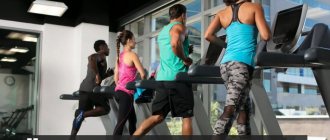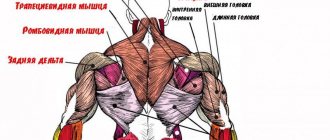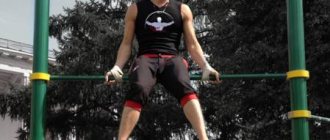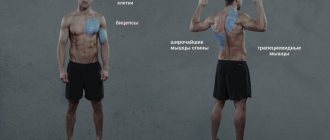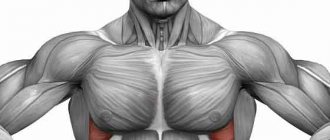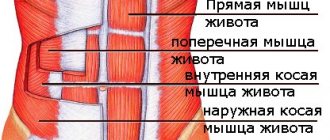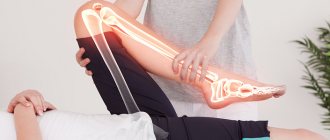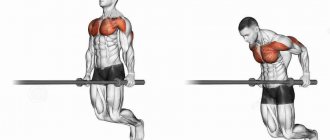Leg raises are one of the most effective exercises for working the muscles in the abdominal area. It is possible to achieve results due to the fact that on the horizontal bar the torso is in a stretched position, and the muscle mass in the abdominal area bears the maximum load, while the legs can be lowered.
There are several types of this exercise: lifting with straight legs, bent at the knee joints, with a twist or inversion. By including all options in your training, you can achieve results faster.
Essence and basic principles
Leg raises on the horizontal bar are an ideal exercise for working the entire abs as a whole. It loads the lower part of the rectus muscle in the peritoneum to the maximum. It is this part of the body, according to experts, that is more difficult to work out; if in the upper part of the peritoneum the cubes are clearly visible after a month of intense training, then the lower part will require more time and more intensive training.
Raising the legs on the horizontal bar allows you to load, in addition to the rectus abdominis muscles, also the external and internal oblique muscles.
If you raise your legs while hanging and add to them twisting the body to the sides, you can significantly increase the load on all muscle groups of the peritoneum and legs. The arms, shoulders and back also receive statistical load. To perform the exercise correctly and in several approaches, you need to have a strong lower back. With weak hands, the grip becomes very weak, but in this case, you can use additional straps to secure the hands to the bar.
Where to start for beginners
If you can’t hang for a long time yet, doing pull-ups is not a reason to give up your goal, because the press bar is your best assistant.
The arm muscles can and should be strengthened; for this there is a special technique, such as the “negative pull-up” exercise.
Stand on a stable stool next to the horizontal bar so that your body is positioned at the top of the pull-up.
Grasp the horizontal bar with bent arms, tense them, bend your legs, transferring the load to your arms. Gradually straighten your arms, lowering your body down.
This exercise will strengthen the arm muscles needed to perform hangs, pull-ups, and other exercises.
Strong muscles of the shoulders and forearms are necessary not only to pump up your abs on the horizontal bar. Working with any weight requires strong hands.
Another option to make the task easier: use horizontal bars, which do not require a strong grip and developed biceps.
You can also successfully perform exercises on it to pump up your abs.
In case of a weak grip, use straps that fix your hand in the desired position and help you work without being distracted at this moment.
Why are they needed?
Exercise on the horizontal bar is recommended if you need to strengthen the spinal column and prevent the development of ailments affecting it.
Such training will help:
- significantly strengthen the muscle corset;
- improve posture;
- normalize blood flow in the vertebral area;
- relieve the load from the discs between the vertebrae;
- relieve pain in various parts of the spine;
- improve back flexibility;
- fix the correct position of the vertebrae.
Raising your legs or hanging on a horizontal bar helps treat and prevent spinal diseases. It is important to include it in training for people leading a sedentary lifestyle.
Beginner mistakes
Abdominal exercises on the horizontal bar must be performed strictly according to the recommended technique. Newcomers to artistic gymnastics make a lot of mistakes.
The most common:
- working without insurance (leads to serious injuries, in some cases incompatible with life);
- setting the wrong grip;
- the correct techniques for pouncing and dismounting are not practiced;
- technically illiterate work with the body and limbs;
- use of questionable techniques;
- the desire to immediately achieve results in full.
Contraindications and possible harm
Raising the legs on the horizontal bar is an effective exercise, but it should not be used in the training process by those who have had an injury to the shoulder joint, forearm, hand, pectoral muscles, or shoulder muscle mass.
The leg raising exercise is contraindicated if you have a previous fracture of the fingers . It is believed that leg raises using a bar will benefit the spine, but in some cases the exercise can be harmful.
Doctors do not recommend using it for people with problems:
- in the cervical spine, for example, with osteochondrosis, dizziness, tinnitus, and general well-being may deteriorate;
- in the last stage of scoliosis, hanging on the horizontal bar can cause deformation of internal organs, which can ultimately cause pinched nerve endings;
- intervertebral hernia, with this diagnosis there is a possibility of displacement of the vertebrae and pinching of the cerebrospinal fluid canal.
You should stop lifting your legs on the horizontal bar if you experience pain in the lumbar region.
Useful tips
You can increase the effect of the exercise if you take into account several recommendations:
- to quickly pump up your abs until sculpted abs appear, training should be carried out 2-3 times a week until a burning sensation appears in the muscles;
- to increase the load on the abdominal muscles, keep your legs bent at the knees;
- when raising your legs, your arms should not be bent or pulled up, they should be perfectly straight;
- experienced and fully trained athletes are recommended to additionally use weights for the lower extremities (heavy shoes or special devices);
- You don’t need to lower your legs all the way, they should stop at 20 degrees, this is the only way the muscles will be tense throughout the entire execution of the complex;
- the chest should be constantly straightened;
- if there is discomfort in the lumbar region, then you need to spread your socks and knees to the sides, while your heels should be pressed tightly against each other, this will make you feel more comfortable;
- When lifting, you need to tuck your pelvis a little, which will ultimately allow you to strain your abdominal muscles to the maximum;
- the smaller the angle between the body and the hips, the greater the load on the abdominal muscles;
- if your grip is weak, you can use special straps for your hands.
If you follow all the recommendations and strictly perform each exercise according to the instructions, you can get a lot of benefits from such a workout.
Among the advantages of a trainer are:
- the entire abdominal mass is ideally worked out, the emphasis is mainly on the lower part of the peritoneum;
- ideal tightening of the lower abdomen, it is possible to create a sculpted and aesthetic appearance in a couple of months;
- core muscles are strengthened;
- prevention of the formation of hernias in the groin and navel areas;
- The walls of the peritoneum are strengthened, thereby ensuring the correct position of the internal organs.
Chiropractors also note that during this exercise, a certain “stretching” of the vertebrae occurs, due to which it is possible to relieve pain. Medium decompression from hanging helps relieve pain associated with the vertebrae.
Rely on the horizontal bar and swing your legs
There are many exercises on the bar. But none of them engage the leg muscles. Your legs don’t swing at all on the horizontal bar, no matter what type of grip you use. To swing your legs on the crossbar, you need to grab the horizontal bar with your foot and pull yourself up with your legs, and perhaps only monkeys are capable of this. A person is unlikely to be able to do this - his foot is not designed for grasping, unlike the lower limbs of primates.
By the way, about our evolutionary ancestors. Why do monkeys have such big hands and such small feet? Because they don't swing their legs. Look at an orangutan or a gorilla - their upper body will be the envy of any bodybuilder. Monkeys acquired such proportions thanks to constant movement through trees and ground using their upper limbs. They either do pull-ups or push-ups from branches in any situation.
As for humans, in order to look harmonious and lead an active lifestyle, we definitely need to train our leg muscles. The horizontal bar will not help here, so we choose separate exercises for the lower body.
Everything is clear with the legs, but what muscles can the horizontal bar actually develop? And there are many of them.
Here is a list of muscle groups that can be pumped up on the horizontal bar:
- Wings or latissimus dorsi along the entire length.
- Upper back or trapezius.
- Shoulders or deltoids.
- Biceps or arm flexors.
- Rectus and oblique abdominal muscles.
When performing an exercise such as muscle-up, you can pump up the arm extensors and a little pectoral muscles. In general, parallel bars exercises are better for the triceps and chest. The bars, as a rule, are always there where there is a crossbar. Therefore, finding this “simulator” should not be difficult for you.
If you want to pump up your torso, exercises on the bar can be combined with push-ups in various techniques. At the same time, you need to train your legs in a way that is convenient for you. If you just want to increase the endurance and definition of your legs, cycling, running, and bodyweight squats can help you. If you want to pump up your legs, then you should use a barbell or bench press.
Today there is a huge variety of exercises on the horizontal bar. Let's look at the most popular of them.
Main complex
The main load when pulling up the legs on the horizontal bar falls on the rectus abdominis muscle. Unlike crunches, the nerve endings that cause the muscle to contract act directly on the lower part of the rectus muscle.
Training program for different levels of training. Table.
Other muscles also work during this exercise:
- tailoring;
- iliopsoas;
- scallop
The oblique is almost not involved if you perform the exercise without moving your legs to the sides.
Corner leg raise
This exercise is called so because of the position of the body at the peak point.
Raising legs on the horizontal bar. Exercise "Corner".
It is done like this:
- grab the horizontal bar crossbar tightly with your hands, look straight ahead, body vertical to the ground, legs together;
- slowly raise your legs up so that they reach the level of parallel with the floor, only the hip joint should move;
- exhaling, linger at the peak point for a couple of seconds, and then slowly lower your legs to the starting point.
The width of the arms is set so that you can hang as long as possible. Typically, this exercise uses an overhand grip, with your palms facing forward and your hands placed on the bar, shoulder-width apart.
Knee Raise
This option for performing the exercise on the horizontal bar is the most common. Simple execution allows it to be used in training beginners and experienced athletes.
Technically it works like this:
- grab the bar with your hands, your body should be straight, your legs should be brought together;
- slowly bend your knees, lifting them up until your thighs are parallel to the floor and your shins are perpendicular;
- at the highest point it will stop for 1-2 seconds and slowly return to its original position.
At the peak point, exhale to empty your lungs of air and tighten your abdominal muscles as much as possible.
Lifting limbs directly to the bar
This exercise is popular in CrossFit. Its advantage is that the abdominal muscles contract to the maximum.
Technically it works like this:
- grab the bar tightly, hands shoulder-width apart, back perfectly straight, legs together;
- slowly raise your legs to the bar and at the same time turn your pelvis inward;
- bring your feet to the bar, touching it with your toes;
- return to the starting point.
There is no pause at the top point, but all because of the extreme straining at the peak point. Perform the exercise as slowly as possible, without jerking.
Lifting with body tucking
During this exercise, the main load falls on the transverse, internal and external oblique muscles.
Technically it works like this:
- firmly grasp the horizontal bar with your hands, hands no wider than shoulders, palms facing forward;
- slowly raise your knees up, lifting your hips up to one side;
- take the starting position;
- raise your knees again, lifting your hips, on the other side of the body;
- return to the starting point again.
Leg raises on the horizontal bar with a ball between the legs
This option is suitable for experienced athletes who want to diversify their training process.
Technically, the exercise is performed like this:
- firmly grasp the crossbar of the exercise machine with your hands, while between your legs, below the knees, you need to hold a weighted ball; you can use a dumbbell as a weighting agent;
- after exhaling, you need to slowly raise your legs, slightly bending them at the knees, to the maximum allowable height;
- fix the body at the highest point for 2-3 seconds;
- slowly lower your legs, aligning your body.
By holding the ball between your legs, you can get additional load. If you properly develop a training program, you can not only build muscle mass and make your abdominal muscles more pronounced.
Alternating leg raises
This option is suitable for those who want to diversify the training process. It differs from the classic lift in that it manages to combine dynamic and static loads. Raising one leg to the height of a right angle, part of the press performs dynamic work, and the second part does statistical work, responsible for ensuring that the body is in a stable position. While performing this exercise, you need to monitor the position of your lower back.
Do not bring the sacral area forward too much, as the spine will twist.
Lifting with inversion
Technically this option works like this:
- hang with a straight grip, hands slightly wider than shoulder-width apart;
- slowly perform straight leg raises and pull-ups;
- then sharply raise your legs up, throwing them onto the crossbar;
- traction occurs towards the center of the torso;
- the revolution occurs at the moment when the mass of the legs is outweighed and they begin to fall down, pulling the body upward;
- when rotated, the crossbar is located at waist level;
- when the legs are lowered, the athlete returns to the starting position - hanging on the horizontal bar.
How to pump up muscles using a horizontal bar
The hands are positioned shoulder-width apart.
Then the position of the hands changes to the opposite with help and again - sharp pull-ups. And if you doubted until a certain point whether it was possible to pump up on the horizontal bar, most likely after a certain period of time all doubts will disappear on their own. It is important not to stop there, but to continue exercising in the same horizontal bar and with the same fighting spirit!
And it’s not difficult to decide whether it’s realistic to pump up on the horizontal bar and uneven bars, based on the above theses. A variety of exercise machines only speeds up the process of muscle development.
I hope that in this article you found the answer to the question posed in the title. How long it takes to pump up on the horizontal bar - we won’t give specific numbers - it all depends on your genetics and the intensity of your workouts.
If you don’t philander and abuse bad excesses - as you will very soon, no - this means that the problem will take a long time to be solved or will never be solved at all. Play sports for fun and don’t forget to subscribe to our blog!
You can pump up, but it will take a lot of time, it’s better to add parallel bars and push-ups to the horizontal bar, then the effect will be good. But what about the biceps on the horizontal bar, I don’t even know, it’s like we’re lifting our own weight, but it seems that not only the biceps works. Therefore, training on the crossbar is an opportunity to relieve the load on the vertebrae and forget about such a symptom as overtraining.
On the subject: How to pump up with dumbbells at home
Please note that abdominal training should be included in every lesson. If you cannot do the exercise with straight legs, then bending them at the knee joint is allowed.
As for other exercises, you are allowed to work in half repetitions until you have enough strength for a full workout. Copying of materials is permitted only with an active hyperlink to the source.
RU Exercises and training At home. How to competently practice at home on the horizontal bar. As an introduction Simple program Complex program Results.
How to competently create a training program for training at home.
Source: https://derevo-dom62.ru/nogi/2691-kak-nakachat-mishtsi-s-pomoshyu-turnika.php
Week schedule
You need to start training with a minimum load, perform as many repetitions as you can until you feel tired in the lower abdomen. You shouldn’t rush into battle right away; it’s better to slowly increase the number of approaches. After just a couple of weeks of regular training, which should be at least 3 per week, you will be able to perform 15 lifts in 3-4 approaches.
The break between approaches is no more than 2 minutes. If the athlete was able to complete 5 or more pull-ups, then you can begin a more intense workout. There must be at least 3 lessons per week, each lasting 1 hour.
Approximately the training should consist of the following program:
| Name | approaches |
| "jumping" pull-ups | 3 approaches, each with 10-15 exercises |
| straight leg pull-up | 3 sets of 10 exercises |
| horizontal pull-up on the bar | 3-4 approaches, each up to 12 exercises |
| alternate leg pull-ups | 3 sets of 10 exercises |
| French press on a low bar | 4 sets of 10 exercises |
| leg lift with ball | 3 sets of 10 exercises |
| reverse grip pull-up | 3 sets of 10 exercises |
| raising your legs to the bar itself | 3 sets of 10 exercises |
Horizontal pull-up on the bar.
This is an approximate workout plan for 1 hour. You can change the exercises periodically, but you don’t need to reduce the load; on the contrary, you should increase it each time. You can add approaches.
When to expect the effect
The first results can be seen on the abdominal muscles after just a month of regular training. It is important that training is regular, at least 3 times a week. The loads only need to be increased, not weakened, the muscles should gradually get used to the loads. After 3 months of regular training, you can see cubes on your stomach, and your body contour will change dramatically.
Raising the legs using a horizontal bar is a simple and most effective exercise for working the abs . Within a couple of months after the start of intensive training, male and female figures will be able to acquire the desired shape and relief.
